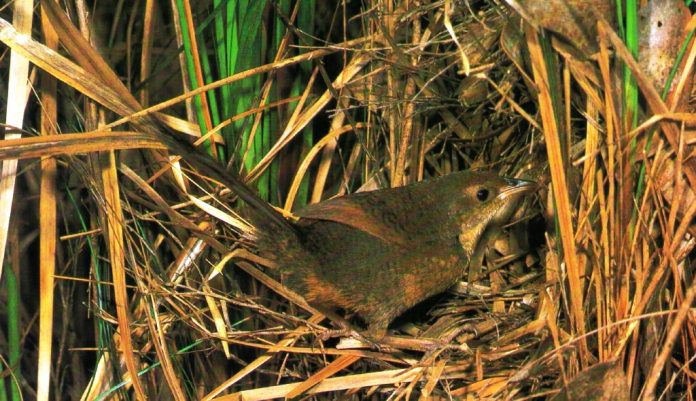The Noisy scrubbird (Atrichornis clamosus) is a terrestrial bird, that spends most of its time on or close to the ground in the dense heathy understorey and thickets of thickly vegetated drainage lines and swamp edges where the microclimate is permanently moist and deep leaf litter covers the ground.
Noisy Scrubbird is a fast and agile runner but a poor flier, using flight mainly to move from shrub to shrub or from shrub to the ground. Because of this persistent habit of keeping undercover and its subdued plumage, it is rarely seen.
The Noisy Scrubbird was first discovered in Australia by John Gilbert, at Drakesbrook in the Darling Range, WA, in 1842, isolated on the other side of Australia from the Rufous Scrubbird (Atrichornis rufescens). It was subsequently found elsewhere in the southwest-at Margaret River, Augusta, Torbay, East of Albany area.
But after 1899 it was not recorded again and was believed to be extinct until 1961 when it was rediscovered at Two Peoples Bay east of the Albany area. To protect the bird, a planned townsite was canceled and a nature reserve was established. There the population, judging by the number of singing males, has increased from 45 in 1970 to 137 in 1983.
In 1983, ten males and six females were Translocated to Mt Manypeaks, 15 kilometers to the northeast of Two Peoples Bay. Each male Noisy Scrub-bird occupies a territory that it defends throughout the year with a loud song that carries for over a kilometer.
The males’ singing increases at the start of the breeding season and remains at a high but variable level until breeding is finished. The males also have a ‘short song’ that incorporates modified songs of other species and is used when interacting with other males or females.
Females only give the two-alarm calls. Territories are well dispersed and average six hectares with a core area of one to two in which the male spends up to 80 percent of his time. At the start of the breeding season, presumed young males may set up small (one-two hectare) feeding territories in sub-optimal habitats where they may sing for up to 12-13 weeks.
Although males may be polygamous, only one breeding female has ever been found in each of their· territories. Many females may breed well outside a territory; these seem to be either young females or older females breeding in unoccupied territories. The female builds the nest, incubates, and feeds the chick unaided.
She may build another nest and re-lay if the first egg is lost, but not if the chick dies. Nest building takes her about three weeks. For the first week after hatching the female is responsible for brooding the chick at night and after every feed.
The chick is fed a wide variety of invertebrates, including spiders, grasshoppers, cockroaches, different larvae, and the sporadic small frog or gecko. After it fledges, it stays with its mother for a month or more, perhaps until its post-fledging molt when three months old.
Females breed in their first year but males most likely do not until three years old. Noisy Scrub-birds feed on a variety of invertebrates-insects, spiders, worms, and larvae-taken mostly on the ground, flushing insects from the litter or turning leaves over with a quick flick of the head. Sporadically they also search up into thick shrubbery under trees.
It is also known as Western Scrubbird. The size of a male bird is about 230 mm; a female is about 200 mm. The male upper parts are brown with fine crossbars of dark brown. Whitethroat forms inverted V above black upper breast; lower breast dull white; belly and flanks buff-brown to rufous. The wings are short and rounded, the tail Zang, and the eyes are dark brown.
Thus, the upper mandible is red-brown, lower is pink-white with pink-brown feet. The female bird is similar; no black on the breast. The immature are head to upper back plain cinnamon-brown; lower back to tail grey; throat and breast cinnamon, grading to gray on flanks and belly.
The downy young are dense, tufted, and gray. The call of Noisy Scrubbird consists of two alarm notes, a loud and harsh squeak, and a softer zit. Three-note call zip da dee. Noisy Scrubbird has the ability of two variable songs. Territorial sang, sharp loud penetrating whistles of 10-15 notes in accelerating descending crescendo, often ending with a sharp crack. Short sang, more tuneful but softer than territorial sang, and does not mimic other birds.
The bird egg-laying is from late May to October. That is a domed shape nest about 200 mm Zang, 180 mm high and 150 mm wide, of rushes with a few leaves and twigs. The short platform leads to the small side entrance. The bottom of the nest chamber is lined with a cardboard-like substance. Nest more often than not in rushes or tangled shrubs about 200 mm above the ground.
Egg: one; pale buff blotched with orange-brown, particularly at the larger end; Zang-oval, 29 x 20 mm whereas the incubation period is about 37-39 days, by a female. The young bird fledges in three to four weeks. The distribution of the Noisy scrubbird is previously in pockets around the extreme southwest coast; now known only from Two Peoples Bay, east of Albany, WA. The bird is sedentary in dense moist copse and thicket in coastal heath and low eucalypt forest. No races.
Read More – The vibrantly Colored Red-bellied Pitta







